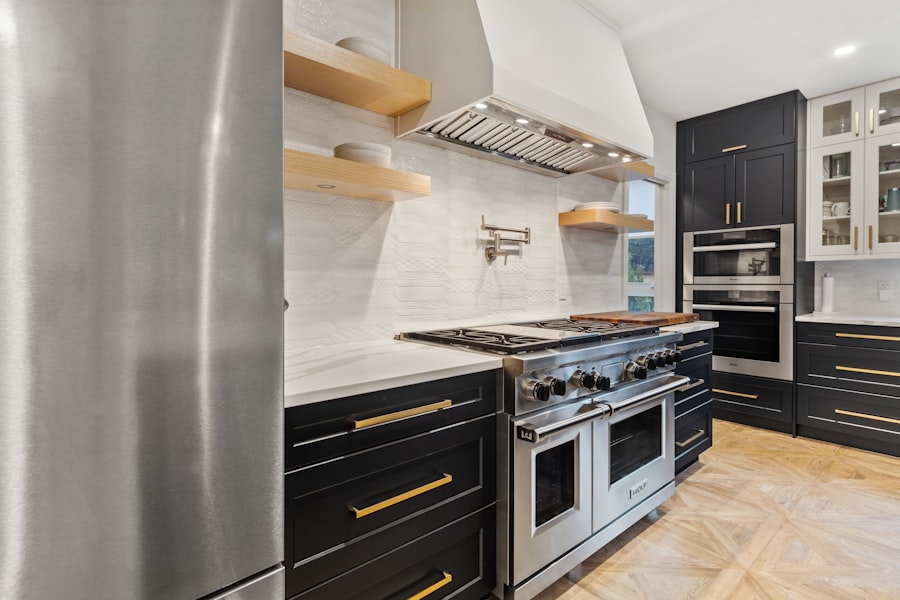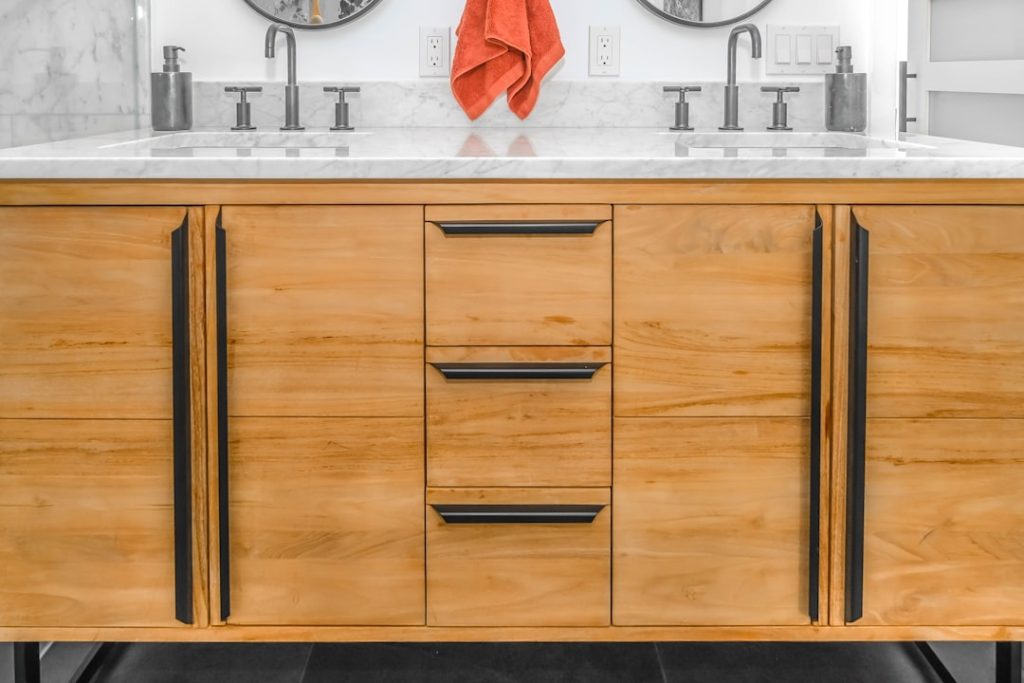Custom cabinets offer a multitude of advantages that extend beyond mere aesthetics. One of the most significant benefits is the ability to tailor the design to meet specific needs and preferences. Unlike pre-manufactured options, custom cabinets can be designed to fit any space, regardless of its dimensions or layout.
This means that homeowners can maximize their storage potential, ensuring that every inch of available space is utilized effectively. For instance, in a small kitchen, custom cabinets can be designed to reach the ceiling, providing additional storage for items that are not used daily, while also creating a visually appealing look that draws the eye upward. Moreover, custom cabinets allow for a level of personalization that is often unattainable with mass-produced alternatives.
Homeowners can select everything from the style and finish to the hardware and interior organization systems. This level of customization not only enhances functionality but also allows individuals to express their unique tastes and preferences. For example, a homeowner who loves cooking may opt for pull-out spice racks and deep drawers for pots and pans, while someone focused on aesthetics might choose intricate moldings and a high-gloss finish.
The result is a space that is not only practical but also reflects the homeowner’s personality and lifestyle.
Key Takeaways
- Custom cabinets offer tailored benefits including optimized space and personalized design.
- The design process involves collaboration to meet specific needs and style preferences.
- Selecting appropriate materials is crucial for durability and aesthetic appeal.
- Custom cabinets can enhance functionality and look in every room of the home.
- Choosing the right designer ensures a successful project that matches your vision and requirements.
The Process of Designing Custom Cabinets
Designing custom cabinets is a collaborative process that typically begins with an initial consultation between the homeowner and the designer. During this meeting, the designer will assess the space, discuss the homeowner’s needs, and gather information about their style preferences. This stage is crucial as it sets the foundation for the entire project.
The designer may take measurements, note any architectural features, and evaluate how the cabinets will interact with other elements in the room, such as countertops and appliances. Once the initial consultation is complete, the designer will create detailed plans and renderings of the proposed cabinets. This phase often involves multiple revisions as the homeowner provides feedback on layout, materials, and finishes.
Advanced design software allows for 3D visualizations, enabling homeowners to see how their cabinets will look in the space before any construction begins. This iterative process ensures that every detail is considered, from the size of each cabinet to the type of drawer slides used. Ultimately, this thorough approach results in a final product that meets both functional requirements and aesthetic desires.
Maximizing Space and Functionality with Custom Cabinets

One of the primary reasons homeowners opt for custom cabinets is their ability to maximize space and enhance functionality. In many homes, particularly older ones or those with unconventional layouts, standard cabinet sizes may not fit well or utilize space efficiently. Custom cabinets can be designed to fit snugly into awkward corners or under sloped ceilings, transforming previously unusable areas into valuable storage solutions.
For example, a corner cabinet can be designed with lazy Susans or pull-out shelves to make accessing items easier. In addition to optimizing space, custom cabinets can incorporate innovative organizational features that cater to specific needs. For instance, a family with young children might benefit from lower cabinets with pull-out bins for toys or games, while a home office could feature built-in file drawers and shelving for books and supplies.
By considering how each cabinet will be used, designers can create solutions that not only look good but also make daily tasks more manageable. This focus on functionality ensures that homeowners can maintain an organized environment that supports their lifestyle.
Choosing the Right Materials for Custom Cabinets
| Material | Durability | Cost Range | Appearance | Maintenance | Best Use |
|---|---|---|---|---|---|
| Solid Wood | High | Medium to High | Natural, Warm, Classic | Moderate (requires polishing) | Traditional and high-end custom cabinets |
| Plywood | High | Medium | Varies (can be veneered) | Low to Moderate | Durable and cost-effective cabinet boxes |
| MDF (Medium Density Fiberboard) | Medium | Low to Medium | Smooth, good for painted finishes | Low | Painted cabinet doors and intricate designs |
| Particleboard | Low to Medium | Low | Varies (usually laminated) | Low | Budget-friendly cabinet boxes |
| Laminate | Medium | Low to Medium | Wide range of colors and patterns | Low (easy to clean) | Modern, easy-care cabinets |
| Thermofoil | Medium | Low to Medium | Glossy or matte finish | Low (sensitive to heat) | Budget-friendly, smooth finish cabinets |
Selecting the right materials for custom cabinets is a critical aspect of the design process that impacts both durability and aesthetics. The choice of wood species is often at the forefront of this decision. Hardwoods such as oak, maple, cherry, and walnut are popular choices due to their strength and natural beauty.
Each type of wood has its unique grain patterns and color variations, allowing homeowners to select a material that complements their overall design vision. For instance, cherry wood offers a rich, warm tone that deepens over time, while maple provides a lighter, more contemporary look. In addition to wood selection, homeowners must also consider finishes and hardware.
The finish not only affects the appearance but also protects the wood from wear and tear. Options range from stains that enhance natural grain patterns to painted finishes that offer a sleek, modern look. Hardware choices—such as knobs, pulls, and hinges—can further personalize cabinets and contribute to their overall style.
For example, brushed nickel hardware may lend a contemporary feel, while antique brass can evoke a more traditional aesthetic. By carefully selecting materials and finishes, homeowners can ensure their custom cabinets are both beautiful and built to last.
Custom Cabinets for Every Room in the Home
Custom cabinets are versatile solutions that can enhance virtually every room in a home. In kitchens, they serve as essential storage for cookware, utensils, and pantry items while also providing opportunities for creative design elements like open shelving or glass-front doors. In bathrooms, custom cabinetry can be tailored to accommodate toiletries and linens while maximizing counter space around sinks.
A well-designed bathroom cabinet can include features such as built-in hampers or pull-out drawers for easy access to frequently used items. Beyond kitchens and bathrooms, custom cabinets can transform living rooms, home offices, and even laundry rooms. In living spaces, built-in cabinetry can provide stylish storage for books, electronics, and decorative items while maintaining a clean aesthetic.
Home offices benefit from custom desks with integrated storage solutions that keep workspaces organized and efficient. In laundry rooms, cabinets can be designed to hold cleaning supplies and laundry essentials while incorporating folding areas or drying racks. This adaptability makes custom cabinets an invaluable addition to any home.
Enhancing the Aesthetics of Your Home with Custom Cabinets

The aesthetic appeal of custom cabinets cannot be overstated; they serve as focal points in any room they inhabit. The design possibilities are virtually limitless—homeowners can choose from various styles such as traditional, modern, rustic, or eclectic to create a cohesive look throughout their home. For instance, shaker-style cabinets with clean lines may suit a contemporary kitchen, while ornate cabinetry with intricate carvings could enhance a more traditional dining room.
Color plays a significant role in enhancing aesthetics as well. Custom cabinets can be painted in bold hues to make a statement or in soft pastels for a more subdued look. Additionally, incorporating contrasting colors—such as dark lower cabinets paired with light upper ones—can add depth and interest to a space.
The choice of hardware also contributes to the overall aesthetic; sleek metal pulls may complement modern designs while vintage-style knobs can enhance traditional themes. By thoughtfully considering these elements during the design process, homeowners can create stunning visual impacts that elevate their interiors.
When comparing custom cabinets to ready-made options, several key differences emerge that influence homeowners’ decisions. Ready-made cabinets are typically mass-produced in standard sizes and styles, which limits customization options significantly. While they may be more affordable upfront, they often lack the quality craftsmanship found in custom cabinetry.
Ready-made options may not fit perfectly in unique spaces or accommodate specific storage needs, leading to compromises in both functionality and aesthetics. In contrast, custom cabinets are designed specifically for each individual project, allowing for tailored solutions that meet unique requirements. The craftsmanship involved in creating custom cabinetry often results in superior durability and longevity compared to mass-produced alternatives.
Additionally, custom cabinets offer an opportunity for homeowners to invest in high-quality materials and finishes that align with their vision for their home. While the initial investment may be higher for custom options, many homeowners find that the long-term benefits—both in terms of functionality and aesthetics—justify the cost.
Finding the Right Custom Cabinet Designer for Your Project
Choosing the right custom cabinet designer is crucial to ensuring a successful project outcome. Homeowners should begin by researching local designers or companies specializing in custom cabinetry. Online reviews and portfolios can provide insight into a designer’s style and quality of work.
It’s essential to look for someone whose aesthetic aligns with your vision while also demonstrating experience in creating functional designs tailored to individual needs. Once potential designers have been identified, scheduling consultations is an important next step. During these meetings, homeowners should discuss their ideas and requirements while assessing how well each designer communicates and understands their vision.
A good designer will ask questions about lifestyle needs and preferences while offering suggestions based on their expertise. Establishing a rapport is vital; effective collaboration between homeowner and designer will ultimately lead to a successful project outcome that meets both functional needs and aesthetic desires. In conclusion, custom cabinets represent an investment in both functionality and style within any home environment.
By understanding their benefits, engaging in thoughtful design processes, maximizing space utilization, selecting appropriate materials, enhancing aesthetics across various rooms, distinguishing them from ready-made options, and finding the right designer for your project, homeowners can create beautiful spaces tailored specifically to their needs and preferences.



